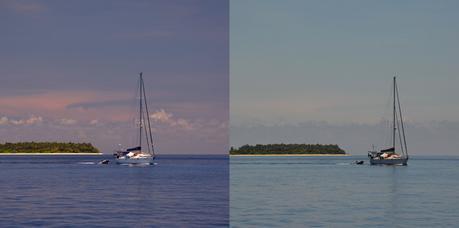
It’s pretty common knowledge among cruisers that you should have polarized sunglasses. They reduce reflected light from the water, and by allowing the wearer to see into the water (instead of a bright glare), making them valuable safety aids for navigating. When I think about the coral heads we’ve dodged in lagoons the last few months, and back in the Pacific, I can’t imagine cruising without them.
This brings up a question. Why don’t more cruisers use a polarizing filter? It is tremendous how they can transform outdoor photos: like sprinkling fairy dust! The effect can’t be reproduced in post-processing software, and they’re very simple to use.
Here are a few pictures- same place, seconds apart, no change except a twist to the polarizing filter on my camera. The filtered view is on the left and un-filtered is on the right.
See how the differences in depth pop? It’s the same principle as polarized sunglasses…can you imagine navigating this without them? No thanks!

Polarizing filters reduce glare so you can see into the water, and peek at the shades of blue- and the bommies- that are otherwise lost. And you get eye-popping color, instead of drab tones washed out by reflected light. Rotate the filter to change the level of effect.

It gives much prettier definition to clouds in the sky, and makes that sky a little darker and bluer as well.

You can use a polarizing filter with a point-and-shoot (see here, or over here, for more info) although really, the best (and intended) use is screwed on the end of an SLR lens. These pictures were all taken on my Nikon D5100

We meet plenty of cruisers who have shelled out for a DSLR to help them beautifully capture all their memories afloat, but treat the camera as a point and shoot and rarely leave the ‘auto’ setting. I’m not going to ding the folks who keep it on auto because this was me for a long time, and it’s still me more than I’d care to admit! I just want to make the point that a polarizing filter is a very simple tool to help cruisers take better pictures, without having to know any Fancy Stuff about how to use all those bells and whistles on a good camera.

The downside to a polarizing filter (and it’s really not a big deal at all), is that it reduces light into the camera by a couple of stops. A camera on auto will adjust a combination of shutter speed / aperture / ISO to compensate for the reduced light. This just means some pictures might be harder to get, or you might want to learn how to get off ‘auto’ and be able to choose which dials to spin to get the kind picture you want, based on your priorities. And, you can always spin the filter so that it’s not really doing much, and voila, more light in. Or awkwardly take the filter on and off while trying to carry the little filter case, which is what I end up doing a lot…but yeah, awkward.
Certainly, there’s more to know about choosing a polarizing filter, and most certainly, I don’t pretend to be an expert here (experts feel free to weigh in!), but I hope this helps anyone thinking of spending a sizable chunk on a nice camera…to spend just a little bit more, and get polarizing filter(s) too.
[We’re somewhere in the middle of the Indian Ocean! This post was scheduled before we left Maldives. We’ll be mostly offline until we reach Seychelles in late June, and look forward to reading and responding once we hit the land of high bandwidth again.]
Shutterbugs know we appreciate when you read this on Sailfeed. Thanks!

